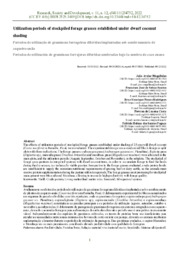Utilization periods of stockpiled forage grasses established under dwarf coconut shading.
Utilization periods of stockpiled forage grasses established under dwarf coconut shading.
Author(s): MAGALHAES, J. A.; SANTOS, F. J. de S.; RODRIGUES, B. H. N.; COSTA, N. de L.; FOGACA, F. H. dos S.
Summary: The effects of utilization periods of stockpiled forage grasses established under shading of 25-year-old dwarf coconut (Cocos nucifera) in Parnaíba, Piauí, were evaluated. The experimental design was a randomized block design in split plots with three replications. The forage grasses: andropogon grass (Andropogon gayanus cv. Planaltina), digitaria grass (Digitaria sp.), marandu grass (Urochloa brizantha) and mombasa grass (Megathyrsus maximus) were allocated in the main plots, and the utilization periods (August, September, October and November), in the subplots. The stockpiled of forage grass pastures in integrated systems with dwarf coconut trees, in order to accumulate forage to feed the herds during the dry season, is a technically viable practice. Irrespective to the forage grasses evaluated, crude protein levels are insufficient to supply the minimum nutritional requirements of grazing beef or dairy cattle, so the animals must receive protein supplementation during the pasture utilization periods. The forage grasses most promising for stockpiled management were Marandu and Mombasa, allowing to reconcile high productivity with forage quality.
Publication year: 2022
Types of publication: Journal article
Unit: Embrapa Mid-North
Observation
Some of Embrapa's publications are published as ePub files. To read them, use or download one of the following free software options to your computer or mobile device. Android: Google Play Books; IOS: iBooks; Windows and Linux: Calibre.
Access other publications
Access the Agricultural Research Database (BDPA) to consult Embrapa's full library collection and records.
Visit Embrapa Bookstore to purchase books and other publications sold by Embrapa.

